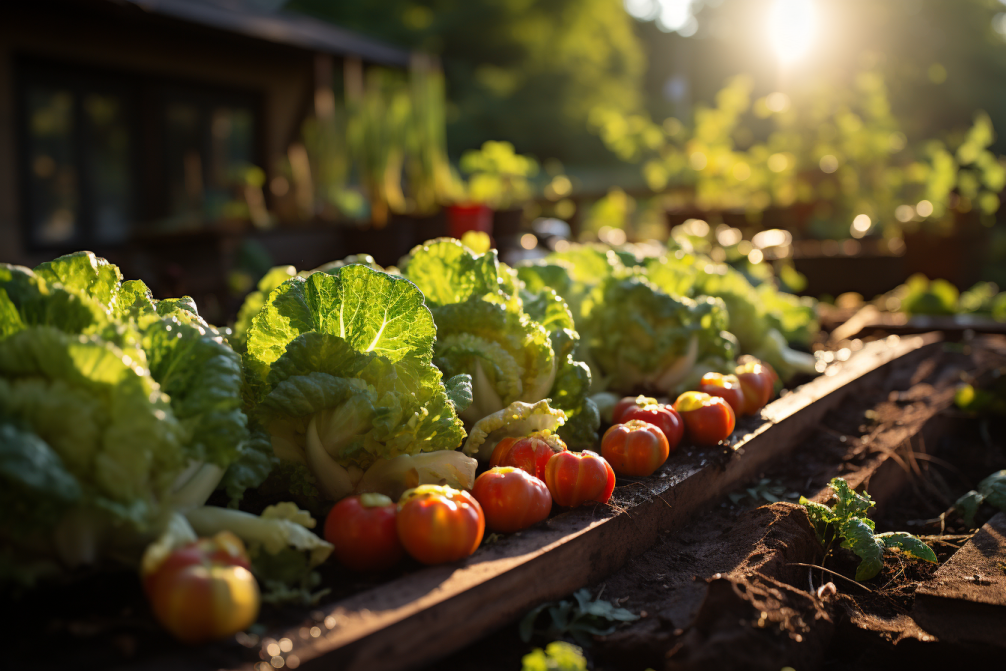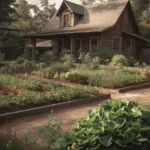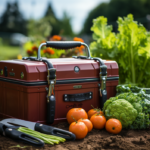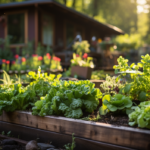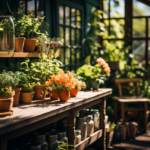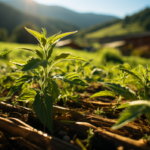Table of Contents
Troubleshooting Your Vegetable Garden: Common Issues and Effective Solutions
Hey there, green thumbs!
Oh, the joys of gardening! That feeling when the first sprouts poke their heads through the soil is simply priceless. But let’s face it, it’s not all roses, and sometimes, despite our very best efforts, things go a wee bit pear-shaped. Those lush cucumbers start to look like they’re on a permanent wilt, the zucchinis develop a funky hue, or the tomatoes… let’s not even get into those splotchy little fellas.
Sound familiar? Fear not! This happens to the best of us. Whether you’re a seasoned gardener or just starting to flex your horticultural muscles, you’ve no doubt encountered one, two, or all of the common vegetable garden problems we’re going to tackle in this post. Heck, it’s part of the gardening journey.
From pests performing a hostile takeover on your greens, wilts and blights playing havoc, or simply bad weather wreaking general chaos, we’ve got you covered. We’re going to be focusing on the most common complaints from the vegetable patch, and providing you with some tried and tested solutions.
So don your gardening gloves, grab that trowel, and keep reading to become the garden whisperer you’ve always wanted to be. And remember, Rome wasn’t built in a day and neither is a healthy vegetable garden. So, let’s dig in, learn about these garden gremlins and how we can tackle them!
Stay tuned because by the end of this post, we’re confident your garden will be back on track to producing those deliciously fresh edibles we all love so much.
Understanding Your Green Space: Common Pests and Diseases
Ah, the green space! A wonderland of homegrown food and a soothing space where you can get up close and personal with Mother Nature. But, alas! It’s also a playground for some unwelcome guests. Let’s explore some of these invaders.
Pests
Pesky invaders can wreak havoc on your precious veggies. Here are some common pests you might find playing merry havoc:
- Aphids: Almost as inevitable as taxes. You can often find these tiny sap-suckers on the underside of your leaves.
- Caterpillars: Nothing ruins your leafy greens faster than these wriggly fellas.
- Slugs and snails: Lovers of damp and cool conditions. These slimy guests are most active at night.
Diseases
But what about when the damage doesn’t seem to suit any creature? That’s when we consider diseases. Here are a few usual suspects:
- Powdery Mildew: Has your plant been dusted with flour? Nope, it’s likely to be this fungus.
- Blight: Usually seen first on leaves, spreading to fruit. It can take down a whole plant if left unchecked!
- Wilt: Noticed a limp plant? It could be a sign of wilt, which can be caused by various fungi or bacteria.
The key to managing pests and diseases? Early detection. Regularly check on your plants, inspecting them for signs of damage. Look out for discoloration, spots, patches, or anything unusual.
Remember, a few bugs don’t mean disaster. Some of them even help pollinate your veggies. However, if things start to get out of hand, it’s time to suit up and get into the action.
But how do you handle these critters and diseases when they show up? And how can you keep your garden thriving? Stay tuned for our next section where we venture into the world of dealing with these common problems.
In the meantime, grab a lemonade, enjoy the sunshine, and keep an eye on those green babies of yours. After all, the best part of gardening is the journey, not just the bountiful harvest.
Troublesome Critters: Dealing with Garden Pests
Well, well, well, the plot thickens! So, you’ve got some uninvited guests who’ve decided your veggie patch is the hottest restaurant in town. Bummer! Not to worry though, we’re here to arm you with some top-notch, critter-busting weaponry. So, let’s charge forth into our solutions for dealing with garden pests.
Natural Predators
One of the most laid-back, hands-off ways to grab this problem by the roots is to invite natural predators. If aphids are your headache, consider attracting ladybugs or parasitic wasps into your garden. Got a problem with caterpillars? Birds could be your new best friends. And guess what loves to snack on slugs and snails? That’s right, frogs and hedgehogs.
DIY Pest Control
Gardening isn’t just about working with nature, it’s also about rolling up your sleeves and making stuff. Here’s some DIY pest control solutions to try:
- Aphids: An infusion of water and mild soap sprayed onto plants can keep these pests at bay.
- Caterpillars: Mix chili and garlic in water and then spray your plants. It won’t harm your plants, but caterpillars hate it.
- Slugs and snails: Beer traps! Half-fill a container with beer and leave it in your garden overnight – slugs can’t resist it.
Garden Maintenance
Fervent garden maintenance can do wonders for preventing pest colonies. Clear away dead leaves and garden debris regularly. Keep the areas around your garden clean and check the soil often. It’s like tidying up a buffet table, keeping it less appealing for pests.
Remember, prevention is better than cure, folks. But if an invasion is underway, it’s not the end of your green thumb days, far from it. There’s no need to throw in the trowel because pests have shown up. We just need a good battle plan.
Stick around, because up next, we’ll be dealing with the arch-nemesis of every gardener – diseases. And oh boy, do we have a tool belt of solutions for you! Until then, keep watching those beautiful plants grow, and remember, the beetles have nothing on a well-prepared gardener!
Battling Disease: Prevention, Identification, and Cure
You’re back! Great to have you here. Now let’s get into the nitty-gritty of an issue we’ve all faced at some point – diseases! Yes, you heard right. Not even our beloved plants are immune to that sniffly, under-the-weather feeling.
Identification
First things first, let’s learn some common symptoms:
- Powdery Mildew: As the name suggests, it’s that unusual white powder on leaves that catches your eye.
- Blight: Look out for large, sudden brown spots.
- Wilt: The hang-dog, tired look, where what used to stand proudly is now on a downward slump.
Prevention – Not Just a Word
Remember that age-old saying, ‘Prevention is better than cure’? Boy, does it ring true here! So, let’s bullet point this:
- Maintain good air circulation. It lessens disease spread and gives your plants space to breathe.
- Plant disease-resistant varieties. There are plenty around, perfect for a lower-maintenance garden.
- Rotate your crops yearly. This stops diseases from getting too snug in your soil.
- Water in the morning so leaves dry out during the day. Damp+Nighttime= Perfect disease ground.
Treatment Time
Ok, prevention didn’t work this time. No sweat! The fight isn’t over. The important thing is not to panic. We’ve got your back. Here are the cures:
- Powdery Mildew: Mix milk with water (1:10 ratio) and spray it over affected plants.
- Blight: Unfortunately, blight-struck plants are usually past saving. The best cure is swift removal to prevent the spread.
- Wilt: This one’s tricky. If it’s bacteria or fungus, remove and dispose of the plant far away from your garden.
Don’t be too disheartened if you lose a couple of plants. It isn’t a failure, but an opportunity to learn and adapt. And trust us, there’s always a solution!
In our next segment, we’re going to talk about over and under-fertilization. Yes, plant nutrients can be a balancing act, but no worries! We’ll help you juggle the process. Meanwhile, always remember: Keep calm and garden on!
Nourishment Gone Wrong: Over and Under Fertilization Solutions
Greetings again, fellow green thuмbs! Let’s talk food – not for us, but for our leafy pals. Fertilizers are like a fine dining experience for our veggies. But guess what? It’s possible to have too much of a good thing, and sometimes, not having enough can put them into a dietary distress too. Yep, we’re talking about over and under fertilization. So, let’s delve into the ins and outs of this nutrient nitty-gritty!
The Problem
Overdoing it with fertilizers means your plants get too much Nitrogen, Phosphorous, or Potassium, which could scorch your plants, stunt growth, or even lead to death. Oh no!
Being stingy with fertilizers could lead to yellowing leaves, poor growth, and lower yields. That’s not what we want, right?
Finding the Balance
Maintaining the Right Balance lies in understanding that different plants have different appetites. It’s all about knowing what your garden patch wants and needs.
Solutions
The solutions fall under three broad categories:
Observation: Check leaves for yellowing, or too many dark green leaves are the first signals indicating under or over-fertilization. Listen to what your plants are telling you!
Soil Testing: Know what’s happening beneath the surface. A soil test will help identify nutrient deficiencies and give you a heads-up if the soil is overloaded with any nutrient.
Slow and Steady: When it comes to fertilization, less is more! Start with small amounts and gradually increase as per requirement. A gradual release of fertilizer works best to maintain balance.
The Bottom Line
Whether it’s feeding too much or too little, the solution is to maintain optimum nutrient levels for your plants. A balance of N-P-K along with micro-nutrients can do wonders for your garden.
Whew! That was a whole lot of food talk! Up next, we’ll be discussing another important aspect that often gets overlooked: water! Too much, too little, how to know the difference, and what’s the sweet balance? Tune in next time to find out and remember, even in a garden, don’t bite off more than you can chew, or in this case, feed!
Wilted Woes: Diagnosing and Solving Issues with Water
Hello again, garden enthusiasts! Time for us to dive into the deep end (pun totally intended!) and talk about the essence of life itself – water. Often underrated, getting your watering habits on point can be a game-changing move for your veggies. So, let’s tackle the common issues and solutions related to watering your garden spot-on.
The Problem
Ever looked at your plants and mistaken them for the weeping willows? That’s wilt for you. On the other hand, those crispy brown leaf edges scream, ‘I’m drowning!’
Diagnosing Water Woes
Keep a lookout for these tell-tale signs:
- Under-Watering: Have sunburned leaves, wilting in the daytime, and slow growth been bothering you? You might need to up your watering game.
- Over-Watering: Veggies looking a bit yellow? Stunted growth, wilting despite wet soil, or root rot could signal water overload.
Resolving the Water Dilemma
Navigating through the trickling streams of the watering world is easier than it seems! Here’s the downpour on how to fix water problems:
Under-Watering:
- Consider adding a mulch layer to maintain soil moisture.
- Try soaker hoses or drip irrigation. They’re slow, steady, and ensure the water reaches the root level.
Over-Watering:
- Ensure your soil is well-draining. Adding organic matter can help improve soil structure.
- Monitor rainfall and adjust watering accordingly.
Easy Watering Tips
- Water early in the morning. This reduces evaporation and helps plants handle the heat of the day.
- Water at the base of the plant. It’s the roots that need the moisture, not the leaves.
- Invest in a soil moisture meter. This will take the guesswork out of the watering game.
Congratulations, you’re now ready to sail smoothly on the waters of gardening. Stay tuned, because next time we will explore how to adapt your garden for different weather conditions. So, until then, remember – just like in life, in gardening too, striking the right balance is the key. In this case, not too dry, not too wet, just perfect!
Climate Considerations: Adapting Your Garden to Weather Conditions
Welcome back, fellow garden gurus! Today’s expedition is into world weather, and no, we’re not playing meteorologists. We’re here to understand how we can adapt and overcome when weather conditions decide to play hardball with our friendly greens.
Identifying the Issue
Whether the sun’s blasting at full throttle, temperatures drop like they’ve seen a ghost, or it’s raining cats and dogs, weather changes can put a real dampener on our garden spirits. Seeing your beloved green babies struggle due to the weather can be heart-wrenching. But don’t you worry, we’ve got some life-saving hacks coming up!
Sunny Days Ahead
Got a garden that’s feeling the heat? Here’s how to keep those veggies chill:
- Mulch it Up: Shield that soil! Mulching helps retain soil moisture and keeps roots cool.
- Water Wisely: Early morning or late evening watering minimizes evaporation.
Brrr…It’s Cold Outside
Frosty weather sneaking up on your veggies? Here’s your action plan:
- The Right Cover: Use garden fabrics or frost cloths as a protective layer against freezing temperatures.
- Bubble Wrap: Bubble wrap around pots can be a great insulator during cold nights.
Making a Splash
Excessive rainfall turning your garden into a marsh? We’ve got you covered:
- Good Drainage: Make sure your soil doesn’t turn into a pool. Add organic matter to improve soil structure and drainage.
- Raised Beds: They help with excess water. Plus, they look super neat!
The trick here is to work hand in hand with Mother Nature, not against her. Observing weather patterns, and building resilient garden practices can pave the way for a healthy, thriving garden.
Next up in our vegetable growing saga, we’re talking soil issues – the root of most garden problems, quite literally! Plant yourself right here for the best dirt on soil solutions. And remember, when it comes to weather, just like any other storm in life, this too shall pass. Happy gardening!
Soil Struggles: How to Improve Soil Health for Thriving Plants
Hey again, gardening comrades! Time to get down and dirt-y, literally! Because today we’re unearthing the mysteries of soil health. If your plants are pulling long faces despite watering and fertilizing just right, you might have a soil issue. Don’t worry, though. We’ll dig deep into this!
Decoding Soil Symptoms
Understanding your soil issues is a bit like a treasure hunt. Here are the clues:
- Your plants look sick despite ample watering and fertilization.
- The soil looks lifeless and lacks earthworms or other beneficial insects.
- Water isn’t absorbing well into the ground.
Amend Away!
Sounds like tough terrain? Don’t hang up your gardening gloves just yet because we have solutions that go beyond just adding compost:
- Test your Soil: Understand your soil type and its pH. This will help tailor the best amendments for your soil.
- Green Manures: Incorporate these plants right into your soil. They decay and add nutrients back into the soil.
- Biochar: It’s a super way to improve soil structure, water retention, and support beneficial microbes.
The Power of Composting
Let’s not totally discard composting though. It’s like the superhero cape your garden soil needs!
- Composting at Home: From kitchen scraps to lawn clippings, you can compost them all. Reward? Nutrient-rich soil amendments!
- Vermicomposting: Red wriggler worms turn your scraps into worm castings, the vocab word for worm poop – known as ‘black gold’ for its nutrient richness!
Bottom line: good soil = happy veggies. A little extra effort into soil health can go a long way in ensuring a healthy, pest-free garden. So, hope you’re now feeling confident to face any soil struggles head-on!
Oh, and stay tuned for our next bit where we’ll cover common gardening mistakes. Trust us, these are so avoidable once you know what to watch out for! Until then, happy gardening, and remember – it’s not dirt, it’s soil… the soul of your garden!
Planting Pitfalls: Avoiding Common Gardening Mistakes
Howdy, green thumb gang! Today we’re doing something a bit different. Instead of addressing specific problems, we’re shedding light on the common mistakes that could be secretly sabotaging your veggie garden efforts. Yes, even the best of us can trip up sometimes – but no sweat, we’re all here to learn, right?!
Strike One: The Sun or Shade Goof-up
Often, the mistake lies at the very beginning:
- Not considering the sun and shade requirements of the plant.
- Or planting sun-loving veggies in deep shade and vice versa.
The solution is simple – always check the plant label or seed packet for sunlight requirements!
Error Two: The Spacing Bungle
Give your plants room to breathe. Crowding can lead to poor air circulation and a higher risk of disease. Remember, your veggies need their personal space too!
Slip-up Three: Overzealous Watering
Watering is essential, but there is such a thing as too much love. Overwatering can lead to root rot. The trick is to keep the soil evenly moist, not waterlogged.
Mistake Four: Neglecting Soil Prep
Great gardens begin with great soil. Ignoring the soil’s texture or pH balance can lead to several problems down the road. A simple soil test can save you a ton of future heartache.
Blunder Five: Ignoring Companion Planting
Certain plants play well together, benefiting each other in terms of growth, flavor, or pest control. For example, planting basil with tomatoes can improve the flavor and also repel pests.
Now that we’ve navigated the common mistakes, remember that mistake-free isn’t part of the gardening lingo. It’s called nature, friends, and every challenge we encounter is part of this amazing, nourishing journey.
Up next, we’ll be wrapping things up with a chat on organic garden remedies, because as we know, the eco-friendly way is the best way! So, plant yourselves right here and we’ll be rooting for you until the grand finale. Happy gardening!
Techniques for Success: Organic Garden Remedies
And here we are, folks, at the final chapter of our garden adventures saga! We’ve dug through pests, diseases, soil struggles, watering woes, and now, we’re wrapping things up on a green note with some earth-friendly remedies. Let’s dive into the bountiful world of organic gardening techniques.
Natural Predators
First on our list is to encourage natural predators in your garden. Ladybugs, birds, frogs – they’re not just charming garden visitors, they’re also nature’s pest control.
DIY Remedies
Got a little mixologist in you? Great! Let’s stir up some organic concoctions:
- Garlic Spray: Blend garlic with water, strain it, and voilà! An organic spray for aphids and other soft-bodied pests.
- Chili Spray: A spicy solution that can keep pests at bay!
- Vinegar Spray: Ideal for fighting fungal diseases. A spoonful of vinegar to a liter of water, and you’re good to go.
Companion Planting
This is a stellar organic strategy to deter pests. Certain plants, when grown together, can help repel pests naturally. For instance, plant marigolds among your veggies to deter nematodes and other garden pests.
Crop Rotation and Diversity
Switching up where you plant certain veggies each year can foil pests and diseases. Also, a mixed planting scheme can confuse pests.
Healthy Soil
Organic gardening always circles back to this: healthy soil equals healthy plants. Regular composting keeps your soil rich in nutrients and teeming with beneficial microbes.
The organic way is all about balance and harmony, folks. It might take a bit more effort and patience, but the reward is well worth it, wouldn’t you agree?
And that brings us to the end of our journey. We’ve traversed through common vegetable garden problems and (hopefully) made you a garden whisperer and an organic champion. So, don that gardening hat, till the earth, plant a seed, and remember to enjoy every step of the journey, as this, in the truest sense, is the real ‘fruit of your labor.’ Happy organic gardening!
Your Garden’s Future: Maintaining a Healthy Verdant Haven
Greetings, garden aficionados! As our journey through the common problems in a vegetable patch comes to a close, let’s envision the future. This final chapter will see us through maintaining that lush, leafy paradise of your dreams – always verdant, always thriving!
Consistent Care
Taking care of a garden is not a one-off task. Checking for signs of pests and diseases, regular watering and feeding, and maintaining cleanliness are all ongoing tasks. So, keep that keen gardener’s eye open!
Love thy Soil
The soul (or should we say ‘soil’?) of your garden needs consistent nurturing, too. Regular addition of organic matter, proper drainage, and soil testing can go a long way.
Seasonal Shifts
Each season brings new challenges and opportunities. Being in tune with these changes and adapting gardening practices accordingly can make a big difference.
Record Keeping
Consider keeping a garden journal. No, not a ‘Dear Diary’, but quick notes about what works and what doesn’t, planting schedules, varieties planted, and pest occurrences can be incredibly helpful for future planning.
Networking
Join a local gardening group or online forum. Sharing experiences and learning from fellow gardeners can be enlightening and a lot of fun!
Relax and Enjoy
Last but certainly not least, let’s not forget the reason why we garden – for the love of it! A healthy garden is not just about never encountering problems but about successfully dealing with them, growing, and learning in the process.
Remember, dear gardeners, the journey is just as important as the destination. So take time to listen, observe, and enjoy the simple pleasures that come along with cultivating your garden. Watch that lyrical dance of butterflies, listen to the symphony of birds, feel the cool soil run through your fingers, and most importantly, admire the remarkable transformation from a tiny seed to mouth-watering veggies.
You’ve now got a toolkit full of garden whispers to troubleshoot like a pro. So here’s to you, to us, and to countless seasons of contented gardening! Stay earthy, dear friends. Until next time!
Conclusion
Alright, green thumb gang, that’s a wrap on our deep-dive into common vegetable garden problems and their solutions! It has been quite the adventure, hasn’t it? From turfing out pests, combating diseases, balancing nutrients, tackling watering woes, adjusting our sails to the winds of the weather, all the way to nurturing the soul of the garden – the soil itself. Quite the journey, don’t you think?
But remember, gardeners, when the sun is beating down or the aphids staging their next invasion, gardening is about cultivating patience along with delicious veggies. The highs, the lows, and even the occasional woes are what make us, well, garden enthusiasts! It’s in understanding and overcoming these challenges that we keep evolving as caretakers of nature’s green bounty.
Keep in mind the nuggets of wisdom we have unearthed together: understand your green space, respect the balance of nature, always observe and learn, and most importantly – keep it natural and organic wherever possible.
So, here’s to gardens teeming with luscious tomatoes, crisp beans, vibrant peppers, and joyous gardeners! Because, ultimately, the greatest yield from a garden is not just the produce, but the satisfaction, learning, and peace it brings to our lives.
Remember – every seed you plant is a new story. Make sure it’s a good one. Until we dig into the next garden-themed adventure together, happy gardening and keep growing!

